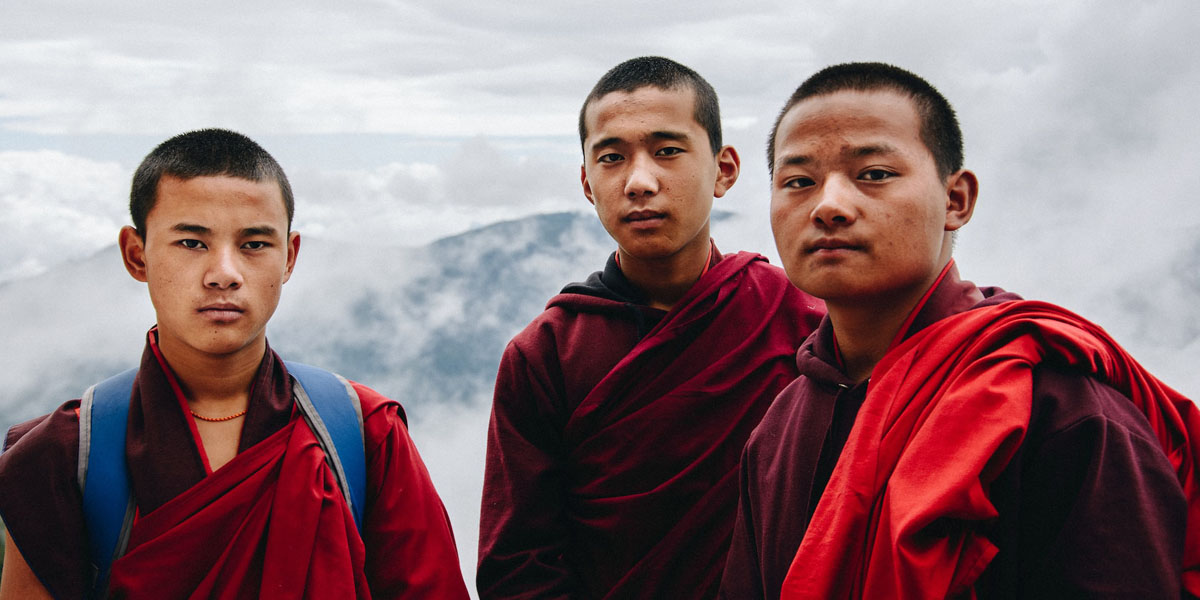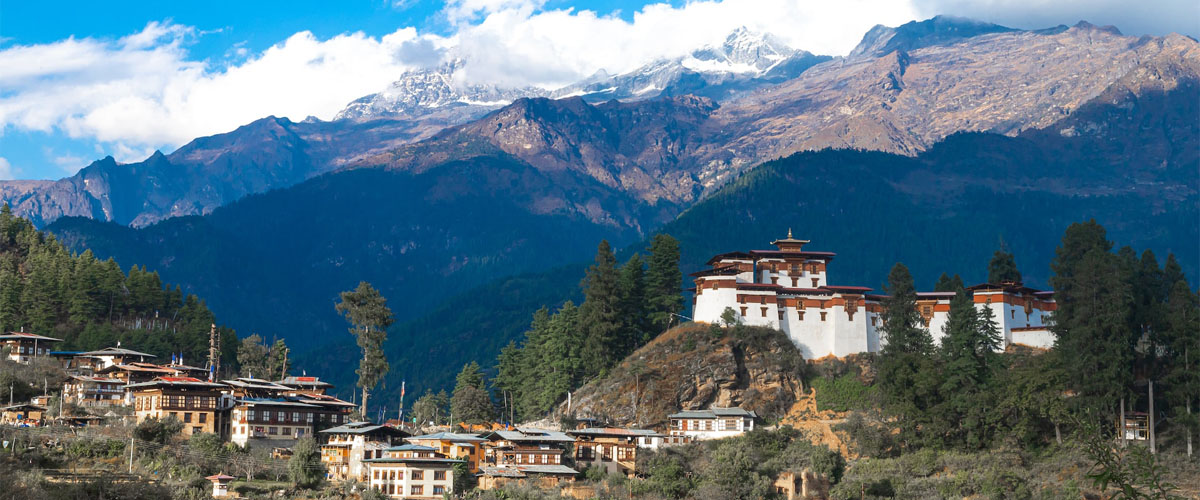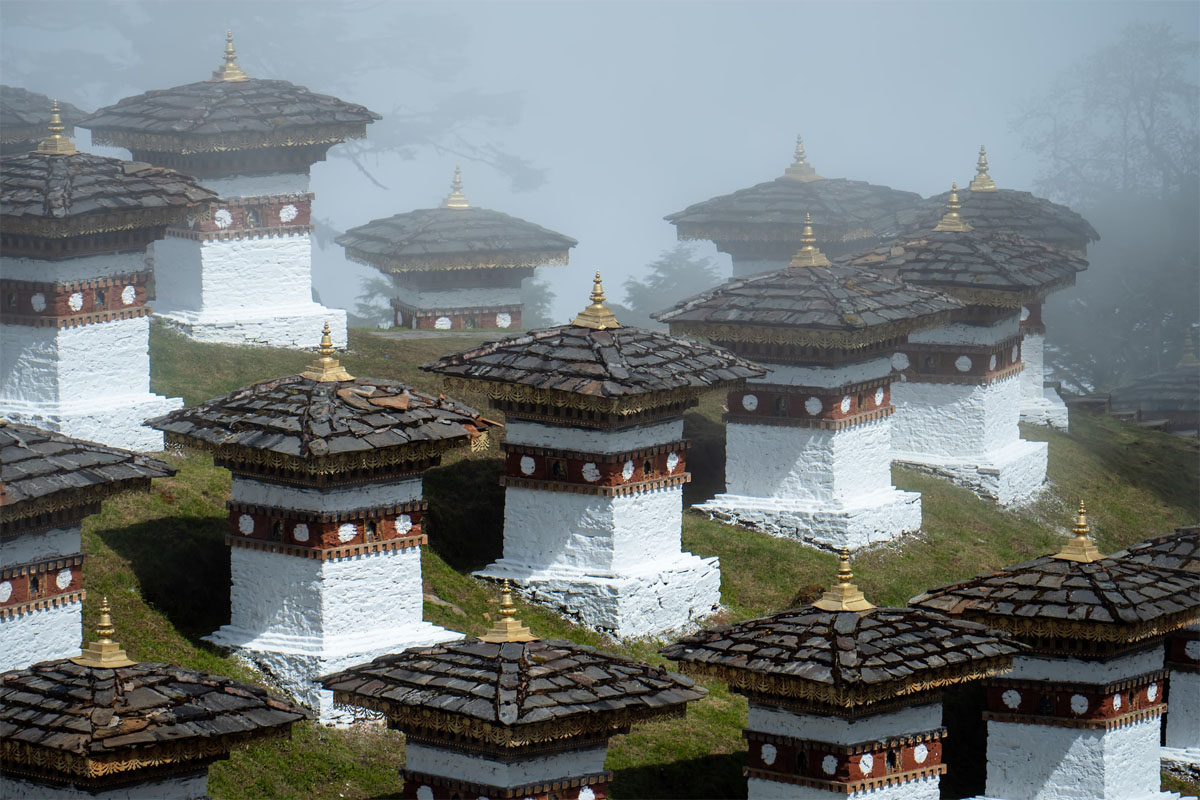Bhutan
Bhutan is situated in between the states of Sikkim, West Bengal and Assam in India and Republic of China in the north. It is also known as the land of Dragon ‘Druk Yul’ or the Land of the Thundering Dragon. Guest can find dragon on many of the building, stamps, arts and many more places. One can enter Bhutan by road from Siliguri through Phuntsholling or from Bagdogra to Paro by flight. Phuentsholling is a small town of the Kingdom of Bhutan nearly 170 kilometers from Siliguri. In the Indo – Bhutan border, Jaigaon is the last hamlet of India and is also the entry point to the Kingdom of Bhutan through Phuentsolling. The Kingdom of Bhutan is a landlocked South Asian state and is known for the great Himalayan range along with the beauty of the place and the colorful people. Situated between India and China it is one of the places in earth where one can find the great Tibetan Monastery and the simple god fearing people. This country is mountainous except for a small strip of subtropical plains in the south towards India which is known as the Dooars. The captivating landscape covered with forest and wildlife with incomparable diversity of flora and fauna, Bhutan is a perfect destination for vacation. Popular among tourists because of the colorful people, Monastery, wildlife, the serenity and its landscapes, guest will be mesmerized by the beauty of this small Kingdom. Bhutan is described and can also be seen as the last surviving refuge of traditional Himalayan Buddhist culture and tradition. Bhutan is linked traditionally and culturally with Tibet and politically and economically it is closer to India. Bhutan currently does not have a railway system. Hence only roadways and airways are the means of transport. Since visitors were allowed from the year 1974 it started gaining popularity slowly. Now the number5 of visitors visits this area in have grown in numbers and are mesmerized by the environment, it is pristine scenery, architecture, culture, the people’s hospitable and charming countryside. Bhutan has to be the most fascinating state in the world offering spectacular views of the Himalayas with its highest peak of Chomolhari.
The climate in Bhutan is congenial for tourist throughout the year except monsoon when outdoor activities are limited due to heavy rainfall. The climate varies with altitude ranging from altitudes of nearly 200 to 4000 meters. It varies from subtropical in the south to temperate in the highlands and polar – type climate, with year – round snow in the north. Nearly a quarter of the area of the country is under forest cover with a very rich species of flora and fauna. It is one of the biological / ecological hotspot of the zone. Till date the Himalayan region of India, Nepal and Bhutan is known for the Ayurvedic medicine. Ayurvedic medicine is popular among Tribes and Buddhist religion. This region is a source of valuable medicinal plants used in ayurvedic medicine so much so that a National Institute of Traditional Medicine has been established at Thimpu.
Flora and Fauna is diversified with huge range of flora and fauna including the tiger, one horned rhino, golden langur, clouded leopard and the sloth bear live in the tropical lowland and forests in the south. In the temperate zone, tiger, common leopard and goral are found in mixed conifer, bamboo, broad leaf and pine forests. Fruit bearing trees and bamboo forest provide habitat for the Himalayan black bear, red panda, squirrel, wild pig and barking deer. The habitats of the north are home to the snow leopard, blue sheep, Tibetan wolf and Himalayan musk deer.
At present there are twenty district of Bhutan. This small Himalayan Kingdom is a unique mix of the old and new. It has a unique population, deeply spiritual and traveler will have a mystical experience. The country is famous for the monasteries and is famous for fruit and red rice production. Languages spoken are Dzongkha, Sharchop Kha, Nepali and English.
Places of tourist interest and important cities are Jakar, the administrative headquarters of Bumthang District. Paro, the site of the international airport, Phuentsholing, the commercial capital / hub of Bhutan, Punakha, the old capital, Thimpu, the largest city and capital of Bhutan, Mongar, Samdrup Jongkhar, Gangtey, Trongsa and Haa are newly developed places.
Thimpu :-
The capital city is in a valley with an elevation of nearly 2320 meters. Thimpu is beautiful and also is the capital of Bhutan. It is also the name of the surrounding valley and dzongkhag in the Thimphu District. It has a population of approximately 55000 with lovely weather. The city is spread across the western slopes of the Wang Chhu river valley. A new road namely Norzin Lam the recently upgraded main thoroughfare, is lined with shops, restaurants, retail arcades and public buildings and is worth a visit by foot. Some of the places of interest like Dechenphu, Tango, Cheri monasteries and Dechenchoeling Palace, the official residence of the King, are located to the north of the city. The beautiful Memorial Chorten dominates the skyline of Thimpu. The Chorten is dedicated to the King Third Druk Gyalpo. Built in the style of a traditional temple the National Library contains a large collection of religious books and manuscripts in Dzongkha and Classical Tibetan along with the collection of English – language books. Changangkha Lhakhang constructed in the 15th century is one of the oldest temples, the National Memorial Chorten at Jangchhub Lam, statue of Sakyamuni Buddhais stunning at sunset, the National Folk Heritage Museum behind the National library, the textile museum, Trashi Chhoe Dzong and Simtokha Dzongare are worth visiting. There are a few parks and preserves like the Takin preserve at Motithang and Coronation Park offers a pleasant environment to stroll. A large Buddha Statue (largest in the world) is under-construction which will be finished on 2008. It will be overlook the city from a mountain top called Kuensel Phodrang. The National Post Office, along Chang lam, is a must visit. It’s a institute by itself where famous Bhutanese export is seen and sold i.e. the various stamps. Philanthropist all over the world knows that Bhutan is the first country to diversify and export quality stamps. Old and expensive stamps are exhibited at the National Museum at Paro. Paro to Thimpu is 55 Kilometers and approximately one hour thirty minutes drive.
Paro :-
It is one of the most historic valleys in Bhutan with an International Airport. From the flight guest can see the Paro Dzong overlooking Paro Chu / river with Ta Dzong, watch tower, now the National Museum, above it. Silvery rivers flows down the valleys, waterfalls plunge down the forested and it is situated at an altitude of some 2190 meters / 7300 feet surrounded by hills and high mountains. To the north is the great snowcapped peaks of the inner Himalaya rise up into the sky are breathtaking beauty of Paro. Politically Paro is bordered by Haa dzongkhag to the west, Tibet to the north, Thimphu to the east, and Chukha dzongkhag to the south. Paro is the only international airport in Bhutan, a beautiful small green – roofed facility in the valley, served by Druk Air and other international carriers. One of the places to visit is Taktshang, or Tiger’s Nest, the most famous monastery in Bhutan. Kyichu Lhakhang are two temple complex and it is the one of the most holy place of the country. The first temple was made by the Tibetan king Songtsen Gampo in 7th century while the second one was made by the Queen Mother of Bhutan, H.M. Ashi Keshang in 1968. This along with Jambay Lhakhang in central Bhutan is the oldest i.e. 7th Century temple in Bhutan, Drukgyel Dzong, at the upper end of the valley, built to protect against invading Tibetans, but in ruins since a fire in the 1950s, Rinpung Dzong, also known as Paro Dzong. This fortress / monastery also is the administrative center of the dzonkhag. The movie Little Buddha was filmed in and around this dzong and there is the National Museum of Bhutan, where visitors can learn about the cultural and historical fact of Bhutan. Evening visit to Paro market or a stroll through town’s main street is a must to enjoy the place.
Haa :-
Haa is one of the dzongkhag or districts comprising Bhutan and is a recent developed destination for tourism. Haa’s major feature is the Haa valley, a steep north – south valley with a narrow floor. The name Haa means the Hidden Land of Rice Valley. There are two roads to Haa from Thimpu, one goes south first and then west, circling around and finally reaching Haa. The other goes directly over the highest pass in Bhutanese roads, Chilela Pass at nearly 3900 meters. In early 2004 the valley was opened to foreign tourist, its tourist resources remain largely undeveloped. Two important temples in Haa are the Black Temple and the White Temple, built at the same time as Kyerchu Temple in Paro in the 7th century A D. The two temples can be found near each other at the sacred site known as Miri Punsum, or The Three Brother Hills. Near the Black and White temples is a special chorten marking the site where an imprint of Guru Padmasambhava’s body and hat may be found in a large rock. In the Samar side – valley there is another holy site i.e. a beautiful Lake. There is a bridge known as Samarpudung, below the bridge is the lake of a wishing cow.
Bumathang :-
This town is the latest addition to the tourist circuit. Bumathang is also known as the spiritual heartland of Bhutan. In this town the most ancient and precious Buddhist sites are located. Bumathang is the home to the most important dzongs, temples and palaces. Some of the places of interest here are the Wangdichholing Palace, the residence of the former king, Ugyen Wangchuk, the temple of Jambey Lhakang, the sacred cave of Kurjey Lhakang and the largest Bhutanese dzong, Jakar is all located here. Whether guest is seeking for leisure, fun filled, adventure vacations, family vacations or any other forms of vacation. We try to help our guest in making the Bhutan tour a memorable experience. Bumathang is one of the most beautiful and most charming of all Bhutanese towns. Its vista is traditional in appearance with wooden slatted houses lining the side of the hill. This kingdom has opened the doors to visitors in the last decade.
Wangdue Phodrang :-
Wangdue Phodrang earlier spelled as Wangdi Phodrang is a dzongkhag of central Bhutan and is also a new additional destination for tourist. The tourism infrastructure is not up to the standard. Yet tourist visits this place for its beauty. The word Wangdue means unification of the country and Phodrang means Palace in Dzongkha. This district is bordered by Dagana and Tsirang dzongkhag to the south, Trongsa dzongkhag to the east, Thimphu and Punakha dzongkhag to the west and Gasa dzongkhag and a small section of border with Tibet to the north. Roads are the only means of transport. There are three paved roads in Wangdue Phodrang dzongkhag. The Lateral Road enters from the west at Dochu La Pass and crosses the Puna Tsang Chhu at Wangdue Phodrang Dzong and proceeds east to Trongsa. Second spur road heads north from Wangdue Phodrang to the Dzong at Punakha and beyond, this road becomes the trail to Gasa. A second spur departs the Lateral Road near the Pele La pass halfway between Wangdue and Trongsa, traveling south a short distance to Gangteng Monastery and the Phobjika valley where the rare black-necked cranes may be spotted.
Trongsa :-
This small town is situated in the centre of Bhutan. This Chökhor Raptentse Dzong at Trongsa was built in 1644 on a mountain spur high above the gorges of the Mangde Chhu. The the dzong controlled east – west trade for centuries. The only road connecting eastern and western Bhutan now known as the Lateral Road passed through the courtyard of the dzong. At the command of the penlop the massive doors could be shut, dividing the country in two. Higher up on the mountainside is a watchtower called “Ta Dzong”, to guard the dzong from enemies. This town of Trongsa is of great importance in the history of Bhutan. His Majesty King Ugyen Wangchuck, who was elected the country’s first hereditary monarch, and his successor, King Jigme Wangchuck, ruled the country from Tsongsa’s ancient dzong. The present King continued this tradition when he was appointed Trongsa Penlop in 1972 shortly before he ascended the throne of Bhutan. Trongsa Dzong is a beautiful, inspiring and an impregnable fortress. It has temples, corridors and offices holding court over the local community. Trongsa is one of the most strange and most charming of all Bhutanese towns. Its vista is traditional in appearance with wooden slatted houses lining the side of the hill.
Phuentsholing :-
Phuentsholing to Paro Tour begins from Phuentsholing which is a main commercial hub in south west Bhutan and is the entry point to Bhutan from India through West Bengal. Popularly also known as the gateway to Bhutan. Phuentsholing is a typical border town and the Indian side is called Jaigaon in the Indian side in West Bengal state. The drive is long but exhilarating journey to Thimphu or Paro last 6 – 7 hours and even more due to stoppages. The road is uphill and guest will come across small Hamlet / villages, waterfalls and wildlife if lucky.
Places of interest in this region are :-
Paro, Phuentsholing, Punakha, Thimpu, Mongar, Gangtey, Trongsa, Haa, Bumathang, Samdrup, Jongkhar


Things to carry :-
From March to September, remember to pack comfortable trousers or jeans, shorts, light t-shirts, walking / sports shoes, sunglasses, caps / hat along with some light clothes. From November to February, carry heavy woolen and warm jacket besides light woolens. A raincoat / umbrella during the monsoon are wise decision. Take along your favorite novel, torch, camera and mobile phone – whatever the season!
General Information for this region :-
Autumn is September and October and it offers excellent weather and mountain views. Winter is December to February is noted for occasional snowfall only at higher elevations. Spring is March to April wild flowers with mountain views and temperature is quite moderate. Summer is May to August with Rainfall and continues up to mid September meadows blossom with flowers and lush vegetation. Best season – October to May is the best season. Clothing – summer – Cottons, winter – Heavy Woolens, Monsoon – raincoat / umbrella is a must. Languages spoken – Hindi, Nepali, and English, etc.
Country Details
-
Address:
Thimphu, Bhutan
-
Visa Requirements:
Required for an International Tourists
-
Country:
Bhutan
-
Languages spoken:
Dzongkha, Bhutani & English
-
Currency Used:
Ngultrum (BTN), Indian rupee (INR)
-
Support Phone:
+91-83350 62800
-
Emergency Email:
bhramonsathi9@gmail.com
-
Distance:
1800 km from Delhi
View On Map
Perfect for those looking to experience the region’s archaeological and cultural treasures in a short amount of time, this adventure includes a four-day trek along the Inca Trail Each has its own personality, unique features, a wide range of small and large group accommodation.





